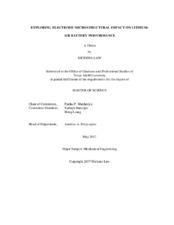| dc.description.abstract | With diminishing fuel reserves, the world is facing quite a dire situation in terms of satisfying global energy demands in the near future. Electrochemical energy storage is going to be an essential part of this solution due to its inherently large efficiency (much higher than Carnot limit of heat – to – work conversion) and sufficiently good reversibility. These electrochemical storage devices have to match the present day fuel economy of gasoline engines for them to present an affordable and realistic solution. Lithium air chemistry is a strong contender to replace internal combustion engines due to their very high energy density (quite comparable to IC engines).
Here one of the reactants – oxygen is freely available from atmosphere and thus possess no storage needs. For Li-air cells using organic electrolyte, Li ions react with oxygen and produce insoluble lithium peroxide (Li2O2). Li2O2 being an electronic insulator, covers the electrochemically active surface of cathode and leads to cell shutdown. Alternatively, the oxygen transport from atmosphere to reaction sites could be slow enough to support desired rate of electrochemical reaction. One direction of improvement is to control morphological features of these precipitates prevent them from covering the reaction surface. On the other hand, electrode microstructure could be played with to prolong time to cell shutdown.
The electrochemical behavior of a Li-air cell is modeled using species and charge conservation. Different performance limiting modes, i.e., surface passivation and oxygen starvation, are identified. The surface passivation limits are characterized from previous experimental studies. Various cathode architectures are realized using stochastic regeneration for different mean pore size and initial porosity. They are further abstracted in terms of porous media properties and used during electrochemical simulations. The simulations explore the effects of discharge rates, microstructural properties, separator and cathode dimensions. | en |


